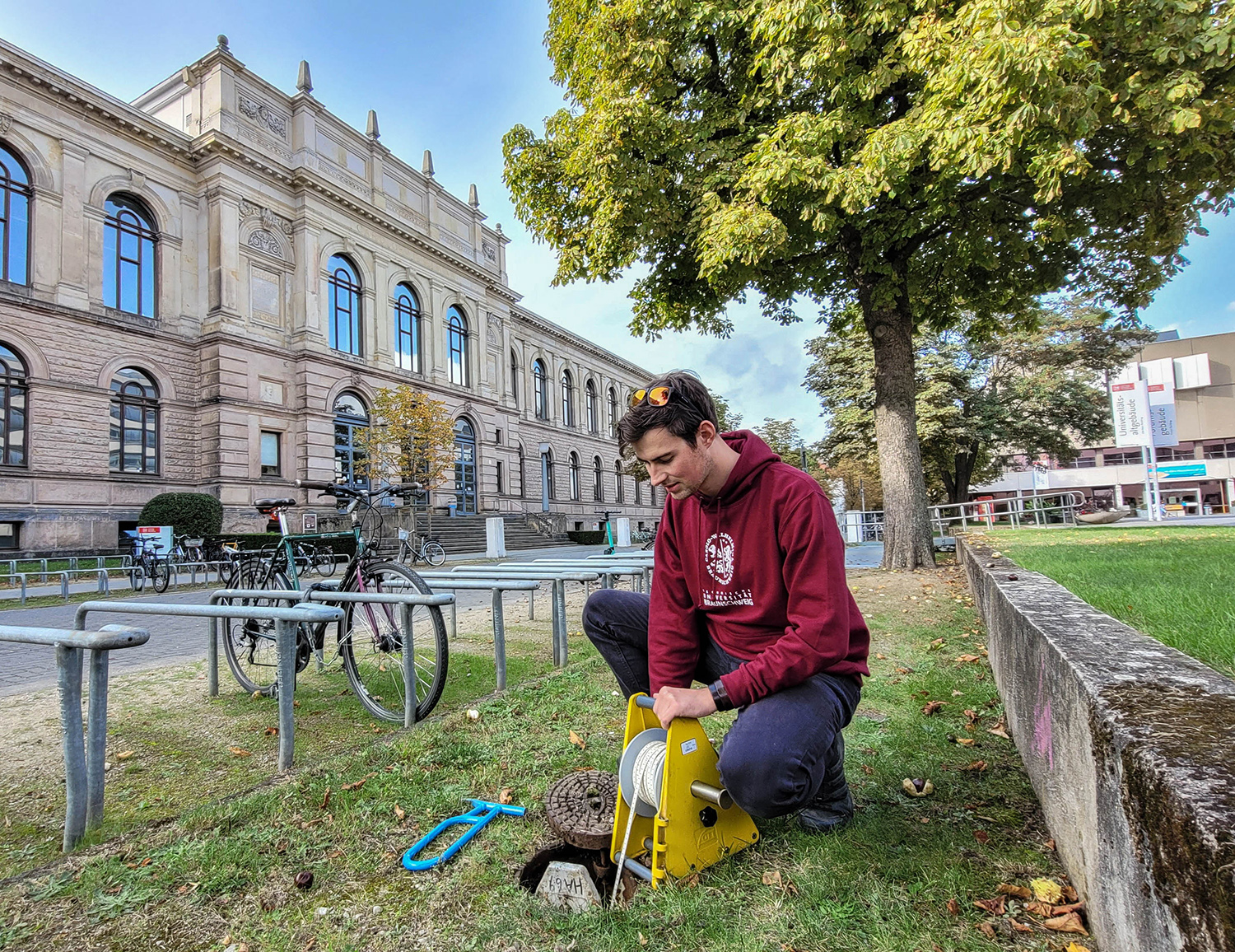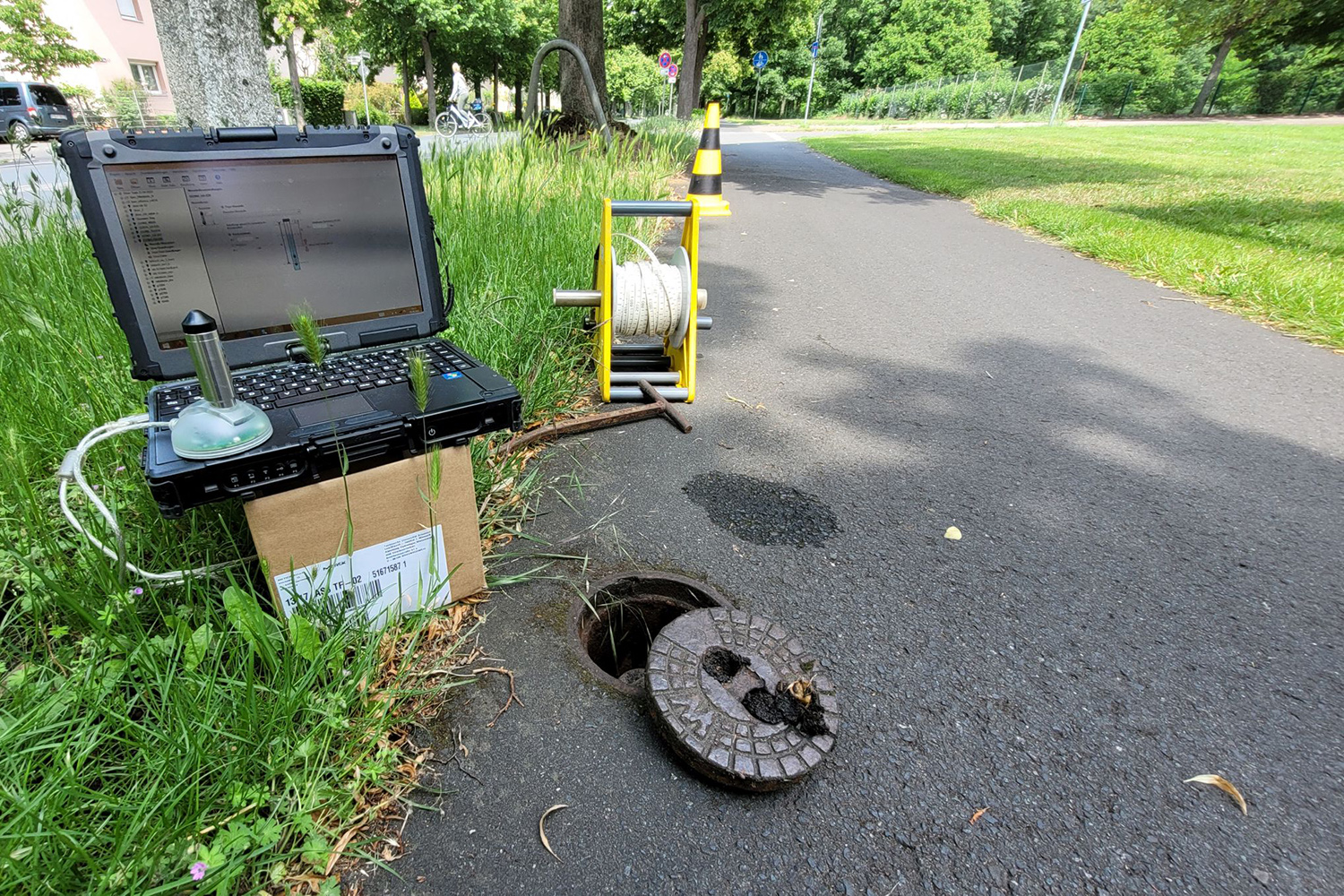The Hidden Water Under Our Feet Leichtweiß-Institute for Hydraulic Engineering and Water Resources conducts groundwater research in Braunschweig
Groundwater – we rarely see it, but it is a precious resource for all of us. This is also true for the city of Braunschweig. Many questions about groundwater in Braunschweig remain unanswered: Where does it come from? How long does it take to travel underground? What is its quality? And how does a managed groundwater body under a city actually renew itself – now and in the future under the influence of climate change? Tobias Langmann and Professor Matthias Schöniger from the Leichtweiß-Institute for Hydraulic Engineering and Water Resources (LWI), Department of Hydrology and River Basin Management, are investigating these questions in a research project together with BS|ENERGY.

Measuring the groundwater level with a cable plumb bob on the central campus of TU Braunschweig. Photo credit: Jan-Hendrik Hilgendorff/TU Braunschweig
Groundwater plays an important role in public water supply. In Lower Saxony, around 86 per cent of drinking water is obtained from groundwater. The city of Braunschweig occupies a special position in this respect, as 97 per cent of the city’s drinking water is currently still obtained via a pipeline from the Upper Harz reservoirs, mainly dammed fissure groundwater from the Palaeozoic bedrock of the Harz. The remaining three per cent of the water comes from the groundwater plant on Bienroder Weg in the north of the city. From 1 January 2024, BS|ENERGY will draw eight million instead of 12.8 million cubic metres of water from the Harz Mountains and supplement the water supply with around five million cubic metres of groundwater from the Oker Valley aquifer in the Wolfenbüttel district.
Ensuring security of supply in the face of drought
Climate change, but also increasing demand for water, is making it necessary to look closely at water supply in order to ensure security of supply in the future. In particular, the dry years of 2018 and 2019, when reservoirs in the Harz region were very low and many rivers had record low water levels, have given us a taste of the extreme situations we will face under the influence of climate change. “New concepts are needed to increase the resilience of public water supplies and to maintain security of supply in the climatically and hydrologically more extreme future,” emphasises Tobias Langmann, research associate in the Department of Hydrology and River Basin Management at the Leichtweiß-Institute for Hydraulic Engineering and Water Resources. “These concepts must not only address issues of capacity and expansion of technical supply facilities for water treatment and distribution, but must also focus on the natural resource water itself. This needs to be better understood and monitored – only then can a natural resource be managed sustainably”.
According to the German Water Resources Act (Wasserhaushaltsgesetz), regional and local water sources have priority in the public water supply. The Bienroder Weg waterworks uses part of a groundwater reservoir beneath the city of Braunschweig. In the HyPoWaBS project (Hydrogeologische Potenzialstudie für die Wasserversorgung der Stadt Braunschweig) (Hydrogeological Potential Study for the Water Supply of the City of Braunschweig), the Department of Hydrology and River Basin Management, in cooperation with BS|ENERGY, is investigating the urban groundwater resources beneath Braunschweig. The aim is to gain a better understanding of the complex groundwater system beneath the city and to identify potential uses in terms of sustainable groundwater management.

Groundwater monitoring with data loggers provides important insights into the composition and dynamics of groundwater in the subsurface, as well as the time series needed for model calibration. Photo credit: Jan-Hendrik Hilgendorff/TU Braunschweig
Effects of climate change on groundwater resources
The effects of climate change on the groundwater supply can be determined using climate scenarios with a water balance model in combination with a numerical groundwater flow model. An important prerequisite for modelling is knowledge of the geological structure of the subsurface of the city of Braunschweig, i.e. the distribution of layers with good or poor groundwater conductivity. For this purpose, the subsurface of the city of Braunschweig was geologically modelled on the basis of drilling information and a geological structure model was created. This was used as the basis for groundwater modelling, i.e. the simulation of groundwater movement in the water-bearing layers of Braunschweig’s subsoil. The work will be supported by a newly launched groundwater and surface water monitoring programme in the urban area.
In their work, the LWI scientists can rely on valuable support from the Federal Institute for Geosciences and Natural Resources (BGR) in Hanover and the „helis – helium isotopes studies Bremen” laboratory at the University of Bremen. Together, the Braunschweig groundwater is being analysed using modern methods based on environmental isotopes (stable water isotopes, tritium and 3He). The results provide information about the origin and age of the groundwater under Braunschweig and thus help to better understand the city’s groundwater resources
Text: Tobias Langmann, Prof. Hans Matthias Schöniger
